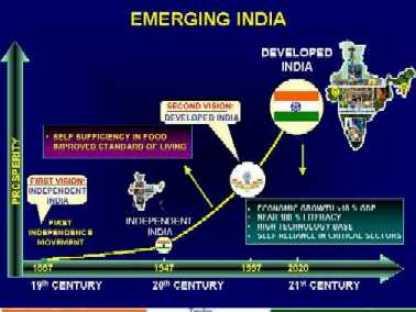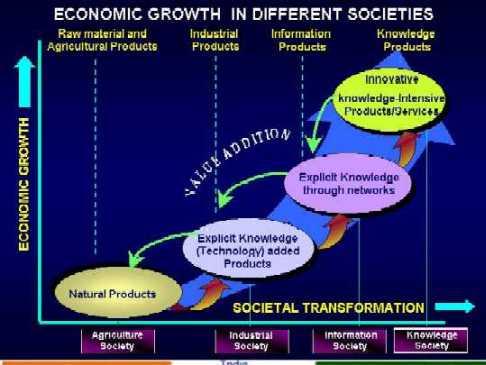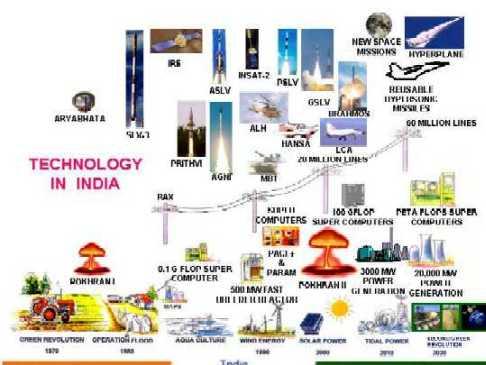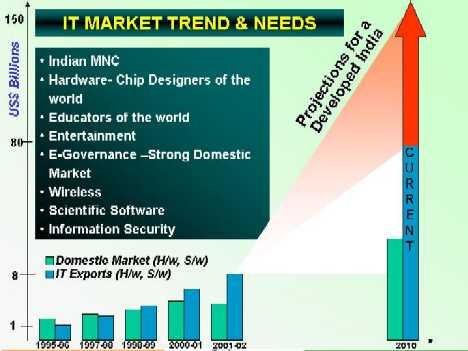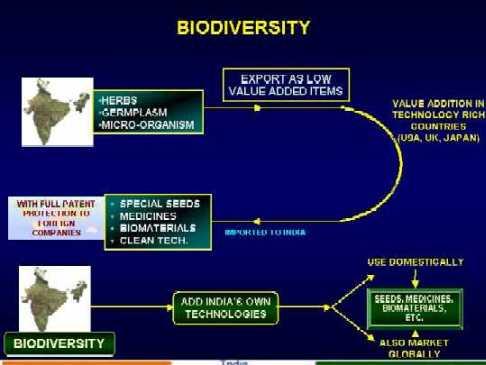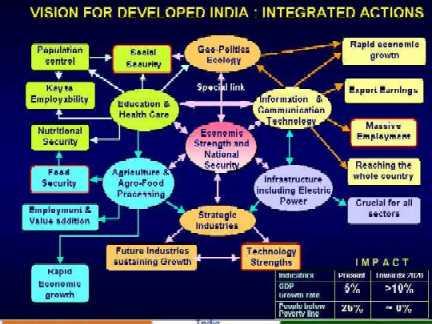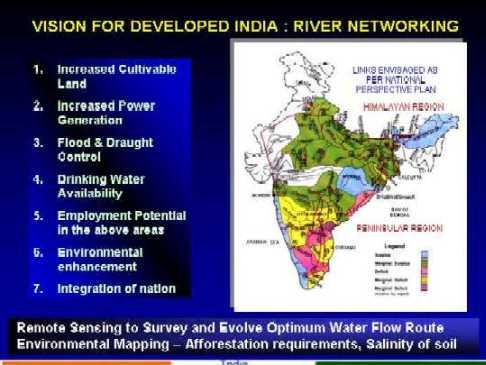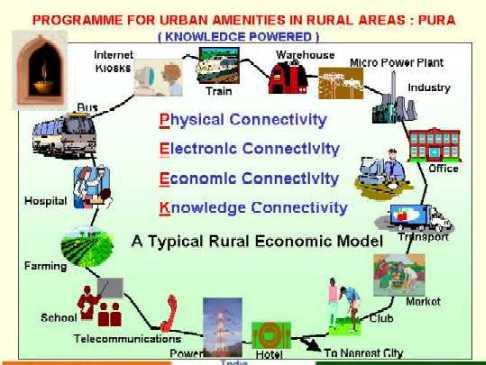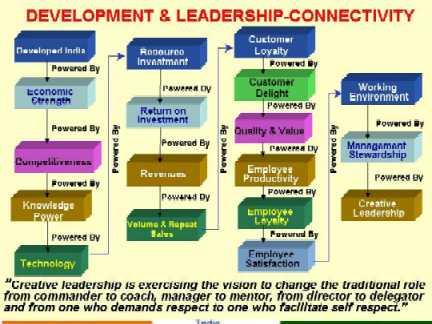Address at the Concluding Session of Interactive Lecture Series India My Dream, Shilpakalavedika Hi Tech City
Shilpakalavedika Hi Tech City, Hyderabad : 07-06-2003
DYNAMICS OF DEVELOPMENT
I am indeed delighted to participate here today on the concluding session of the Interactive Lecture Series "India - My Dream" organized by Hyderabad Management Association. My greetings to all the ten speakers who have very effectively brought out the road map for developed India in each core sector. During the last ten months, I have visited 21 states and interacted with a large number of political leaders, farmers, students, teachers, spiritual leaders and rural people. I know the dream of the people of India is to live in a prosperous, happy, peaceful and secure nation. I would like to discuss various aspects of development and my thoughts to give a road map for developed India.
As you are aware, the Prime Minister in his Independence Day address on 15th August 2002 resolved to make India a developed country by 2020 and the same has also been incorporated in the 10th plan with a focus on allround development and deliberated in the National Development Council. The government has also appointed a task team for formulating an action plan for networking of rivers. With this positive direction of movement the technological strides we have recently made and the enthusiasm of our youth, I am sure India can be transformed into a developed country.
Emerging India
The first vision for the nation was achieving independence which we got in 1947. The independence movement threw up various leaders in diverse fields like politics, philosophy, judiciary, science & technology and industry. In many areas, improvements also took place like literacy, agriculture, strategic areas, certain small and large scale industries. However, in spite of this even after 50 years we are counted among one of the developing countries, in a distinct way a separation from G8 countries. We have many challenges. Nearly 260 million people are still below poverty line and have to join mainstream of good life. 100% literacy, wealth for all, multiple industrial and agricultural productivity, 10% GDP growth rate has to emerge. Hence, we need the second vision for the nation to become a developed country.
Economic Growth in different Societies
During the last century, the world has undergone a change from agricultural society where manual labour was important to an industrial society where management of technology, capital and labour was of importance. Now, in the 21st century, we are into the knowledge society where knowledge is the primary resource instead of capital and labour. Efficient utilization of knowledge can create a comprehensive wealth for the nation and improve the existing quality of life. In such a society, the integration and effective use of IT in various sectors like industry, health care, education will be the key for achieving the prosperity.
Changes in Employment, Agriculture, Industry and Service-Knowledge industries
Human resources, particularly with large young population, are unique core strength of the nation. This resource can be transformed through various educational and training programmes. Skilled, unskilled and creative manpower can be transformed into wealth generators particularly in the service sectors, agro industries etc. If we see in the last four decades, the employment pattern in agriculture and services sector has undergone a sea change. In 1960, in India, agriculture areas employed in parts or in full 74% of people of the country and it reduced to 62% in 1992 and expected to further fall to 50% of people in agriculture by 2010. Whereas, the demand of agricultural products will double in quantity, productivity using technology and post harvest management will have to compensate the manpower reduction in farming and agricultural products sector. In the case of industry, in 1960, 11% of the population was employed in small scale and large-scale industries. The trend continued with 11% even during 1992. However, it has to increase by 25% in 2010, as the GDP growth with high technology in the situation of opening up of the economy under WTO regime. The pattern of employment will take a new shape. Service with knowledge industry component from 15% employability in 1960 has increased to 27% in 1992. And further it will increase to 50% in view of infrastructure maintenance areas, financial sector, IT sector and entertainment demands. If we compare it with USA, the knowledge industry component has increased from 57% in 1960 to 72% in 1992 and is expected to increase to 95% by 2010. This big change will demand in all areas more trained skilled human power and technology personnel. Industrialists, commercial chiefs and technologists in India may have to get ready for such transformation in agriculture, industries and service - knowledge industries for which human manpower with knowledge and skills has be evolved in mission mode.
Technology in India
India after independence was determined to move ahead with planned policies based on socialist pattern through five-year plans. On account of the green revolution, India is now self sufficient in food. The operation flood has made India, the largest producer of milk in the world. Health services have also been improved since independence with increase in life expectancy from 33 to 64 years, fall in infant mortality from 148 to 71 per thousand, and eradication of diseases like small pox, cholera through vaccination etc. Small-scale industries provide a significant percentage to the national GDP. India is in a position to design, develop and launch world-class communication and remote sensing satellites. India is having capability of building large Thermal and Nuclear power stations. Defence research has led to many significant developments in weapon systems like strategic and cruise missiles, sonars, underwater weapons, light combat aircraft, tanks, electronic warfare systems and various armours. India has a strong base in the development of information technology and the country is progressing in hardware and software business of more than $10 billion. Yet, India is a developing country.
Information and Communication Technology
Knowledge in the form of information technology has opened up the opportunity for India to become premium provider of computer software and IT enabled services to the industrialised world. In most of the developed nations, ICT contributes around 7 to 8 percent of their GDP, which is expected to rise to around 25% of GDP by the year 2010. As far as India is concerned, ICT today accounts for nearly 2% of GDP. We have to enhance this significantly. IT has not only provided the employment but also has revolutionised the way of working in all spheres of economy by bringing in speed, quality and efficiency. It is also transforming the way we communicate among ourselves and with the rest of the world, shrinking the distances between the hemispheres. To sustain the growth in software industry one has to think of newer strategies. So far, software development in the country has been concentrated in selected cities like Bangalore, Delhi, Hyderabad, Pune etc. It is yet to percolate down to smaller cities and towns. The government had established the Software Technology Park in selected metropolitan cities but still the problem remains. One method of overcoming this problem can be that established firms can form a nucleus where core activities can be performed around which smaller firms in rural and small towns can perform the non-core activities. These networks need not have geographical proximity. However, to take full advantage of the technological developments, investments in communication area have to be made. Rapid expansion and extension of India's fixed and mobile telecom infrastructure is essential for stimulating growth in this sector. Strengthening of the optical fibre backbone and providing Wireless Local Loop (WLL) technologies in rural areas can go a long way in providing the benefits to the rural people. Rural information networks can allow knowledge services, money and certain kinds of product to flow more easily across long distances. The widespread use of Internet is creating the possibility of reorganising and networking government services to make them more user transparent and efficient. I am happy to know that some states have introduced e-governance to provide a single window clearance to their people. Andhra Pradesh is one of the few states, which has taken the lead in introduction of Information Technology in governance. Other areas which can be concentrated upon in the IT sector include information security, scientific software development, entertainment, education, hardware and chip design etc. The Indian MNCs could aim at a target of 150 billion dollars by the year 2010. We must establish our own 'Brands'.
Bio-diversity: a core competence of India
India is rich in herbs, germ plasma and micro organisms. Presently, the industrially developed countries are importing these bio resources, adding value and exporting this as special seeds, bio materials to developing countries including India. They also fully protect patents of these products. Instead of importing these products at a high cost India should develop its own technology for conversion of such resources to meet its requirement. Particularly, in the herbal area, there are potential application for developing multiple products for nutrition, prevention and cure of certain diseases. Of the global herbal product market of 61 billion dollars, China has a share of around 3 billion dollars where as India's share is not even 100 million dollars. Hence, there is tremendous opportunities for increasing the market share. India has similar potential for promoting floriculture and aquaculture in a big way.
Convergence of Technologies
It is very important when teaching enrich research, research is enriched by teaching. Hence, I expect this Centre and its Faculty to visualize a situation, that is convergence of technologies. The information technology and communication technology have already converged leading to Information and Communication Technology (ICT). Now, nano-technology is knocking at our doors. It is the field of the future that will replace micro electronics and many fields with tremendous application potential in the field of medicine, electronics and material science. When nano technology and ICT meet, an integrated silicon electronics, photonics is born and it can be said that material convergence will happen. When communication technology integrated silicon electronics, photonics and sensors converges, we find radio chip and intelligent roaming. When biological science added with radiology, super humans will emerge. That means knowledge powered human beings. There will be nothing like an exclusive subject like bio technology, information technology or robotics science, in future. They all try to converge. Better this Institute is aware of the trends of the future so that we prepare the students and the research areas in the most useful and profitable way.
Integrated Action for Developed India
In order to realize developed India by the year 2020, five key areas have been identified for an integrated action (1) Agriculture and food processing - with a target of 360 million tonnes per annum of food and agricultural products.. Other areas of agriculture and agro food processing would bring prosperity to rural people and speed up the economic growth (2) Electric power and infrastructure (3) Education and Healthcare- aiming to increase the employment potential leading to social security and population control (4) Information and Communication Technology - This is one of our core competence. We believe this area can be used to promote education in remote areas and also to create national wealth through export earnings (5) Critical Technologies and Strategic industries - the progress in nuclear, space and defence technologies will provide sustained growth and self reliance for the nation.
These five areas are closely inter-related and lead to national, food and economic security. A strong partnership among R&D, academy, industry, business and community as a whole with the Government departments and agencies will be essential to accomplish the vision
Networking of rivers
Networking of rivers is essential for flood and drought control, for availability of drinking water to all regions, for goods navigation and transportation and for increased power generation and cultivation land. This mission will also provide employment opportunities to the rural population. Science and technology can surely help in executing such mission. Remote sensing to survey and evolve optimum water routes, environmental mapping and afforestation requirements, and continuous monitoring of the networked water flow through all seasons and at all times may require a dedicated satellite constellation for our networked river systems. Above all, the networking will lead to enhancement of environment and national connectivity.
Knowledge powered PURA (Providing Urban Amenities in Rural Areas)
Development of rural infrastructure cannot be viewed in isolation. An integrated strategy is required. In future, the development of urban infrastructure will further widen the urban-rural divide. Therefore, villages have to be connected suitably to form urban areas. An example of this is PURA that will bring rural wealth and prosperity. This model envisages a habitat designed to improve the quality of life in rural places and makes special suggestions to remove urban congestion also. Naturally our most demanding urban problem is that of congestion removal and efficient supply of water and effective waste disposal in every locality are the paramount civic needs. There is a minimum size below which a habitat is not viable and not competitive with the existing congested city. At the same time, the existing congested city is not economical compared to a new town once a minimum size of expansion is crossed. As against a conventional city say, rectangular in shape and measuring 10 km by 6 km, the model considers an annular ring-shaped town integrating minimum 8 to 10 villages of the same 60 sq. km area, and the same access distance of 1 km to transport arteries. It needs one and only one transportation route of distance half that needed for the rectangular shaped city; so frequency of transportation will be doubled having waiting times. It has zero number of junctions and will need only a single level layout. Also it needs only one route as against 8 needed for the rectangular plan, so people will no longer need to change from one line to another to move from any one point to any other. That saves transport time. Further, as all traffic is concentrated into one single route, high efficiency mass transportation systems become economical even for a comparatively small population. This cuts costs substantially and is more convenient for general public. Decentralisation of municipal governance and greater reliance on institutional financing and capital markets for resource mobilisation can be one of the means to develop urban centres in rural areas.
Infrastructure Rural Urban Divide
A major problem in the infrastructure sector has been the increasing disparity with regard to the facilities between the urban and rural areas. Over the last three decades, there has been a large concentration of the urban population in a small number of urban centres thus putting a large burden on infrastructure like public transport, water supply and sanitation, power etc. This needs to be corrected on an urgent basis by proper urban planning, growth of new townships, involvement of private sector in infrastructure development, innovative modes of transport like metro projects to ease urban congestion, etc.
Transportation
Regarding infrastructure, another problem facing India has been the lack of proper expressways connecting important cities. Whereas the traffic has increased many folds between the cities, much is still left to be done for building the infrastructure in the form of expressways. Therefore, expressways need to be constructed between all major cities to ease the movement of goods by the commercial vehicles and passenger transportation. Railways will also have to be expanded to handle a three-fold increase in traffic. For this purpose improve customer service, comfort and safety, a reduction in freight, cost and tariffs and elimination or reduction of uneconomic services will be necessary. We also have to look for alternative modes of transport like transportation by using the river network. Incidentally, rivers are also the backbone of the water resources.
Utilizing Water Resources
India as such not poor in water resources what it lacks is the ability to efficiently to utilise the resource for the maximum benefit. Both urban and rural water resources can be substantially enhanced by widespread adoption of rainwater harvesting techniques. Given the enormous cost of major water projects, emphasis needs to shift from large-scale projects for augmenting water supply to decentralised projects designed to manage water demand and conserve water resources. Rivers can also help in providing much needed water to areas which have been traditionally dry. There is a possibility of a scheme by which 14 Himalayan tributaries of the Ganges and the Brahmaputra rivers in the Northern India can be linked and the same is transferred to south via series of canals and pumping stations across the Vindhya Mountains to replenish 17 southern rivers including the Godhavari, Krishna and Cauvery. The scheme needs to be studied by the experts.
Power
It has been estimated that the soaring demand for power will necessitate a tripling of the installed generation capacity from 101,000 to 292,000 MW over the next two decades. Besides increasing investment in conventional power generation routes like thermal and hydro, greater emphasis need to be placed in the generation of power using nuclear energy and renewable energy. In this respect, India is already the world's fifth largest producer of wind power with more than 95% of the investment coming from the private sector. Other renewable energy technologies like solar photovoltaic, solar thermal, small hydro and biomass power etc. also need to be augmented. An important aspect which needs attention is power distribution. For instance, the rural electrification programme launched in 1951 has succeeded in bringing electricity to more than 5 lakh villages. However, 80000 villages are yet to get electricity connections and quiet a few of them are in remote areas where conventional electricity grid may not be feasible. Therefore, in rural areas, non-conventional energy sources like generation of power from biomass, wind, solar power can be tried out.
Small scale industries and entrepreneurship
The small-scale industries sector plays a vital role in the growth of the country. It contributes almost 40% of the gross industrial value added in the Indian economy. It has been estimated that a millions of rupees invested in fixed assets in the small-scale sector produced 4.62 million worth of goods or services with value addition. The number of small-scale units has increased from 0.87 million units in the year 1980 to over 3 million now. This also provides largest employment opportunities for the Indian population next only to the agriculture. 45 to 50% of Indian exports is contribution by SSIs. It is expected through technology upgradation value addition techniques, credit support, marketing strategy and declared export zones, the present 32.25 lakhs of units can be increased to 150 lakhs yielding additional employment opportunities of 13 million people with a production target of Rs.25,000 billion per year by the year 2020. The product includes sport goods, garments and knit wear, plastic product, processed food, leather products, engineering goods, etc. with less capital investment the small scale industries generate large employment opportunities and generates wealth for the nation.
Creative Leadership
India has abundance of natural resources and human power. The nation needs young leaders who can command the change for transforming India into a developed nation. These leaders should be the creative leaders who can lead the new organisations of excellence. Who is that creative leader? The creative leadership is exercising the task to change the traditional role from commander to coach, manage to mentor, from director to delegator and from one who demands respect to one who facilitates self respect. The higher the proportion of creative leaders in a nation, the higher will be potential of the success of visions like developed India.
Conclusion
When the nation is in developmental mode, the most important need of the country is an integrated developmental plan and empowered management structures in the areas of Education and Healthcare, Agriculture and Food Processing, Information and Communication Technology, Strategic Sectors and Infrastructure Industries. In addition, I would like to suggest various missions for our people. For example, the student community can take the task during holidays to remove the illiteracy of certain number of people in their area where their school or house are situated. Only a burning candle lights another. Teachers and parents can assist them in this task. The Government and R&D labs can provide technological upgradation to our small-scale industries so that production can be increased and be competitive. The large-scale industries have to increase their contribution for economic growth particularly GDP growth. Here, the industries can concentrate on maximum output and cost effective products, so that the demand will increase. They can aim to become multinational companies, for e.g. in the areas of sugar, power, cement and engineering and knowledge institutions. The farming community, where there are with dry land cultivation have to increase their productivity with the help of available new scientific methods. The Information Technology and knowledge workers have got a tremendous responsibility to contribute in the areas of tele-medicine, tele-education and e-governance for rural areas apart from their business role. In this vision period, the whole Government agency, has to build a name for itself, by fast decision making and transparent administration. Media has to become a partner and promoter critic in national development. This type of motivated environment will be indeed a great foundation for our vision of transforming India into a 'developed' nation.
Thank you.

